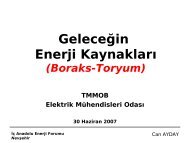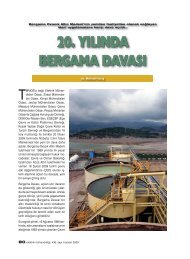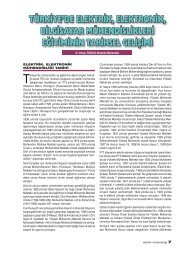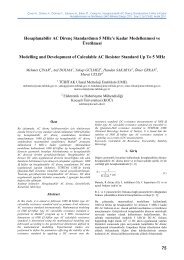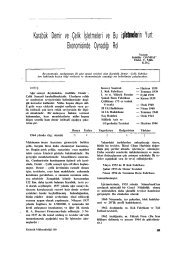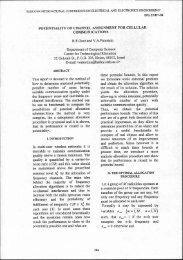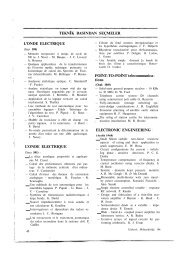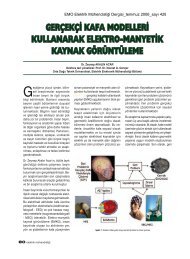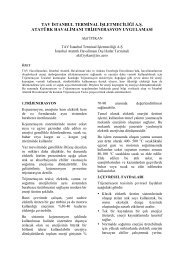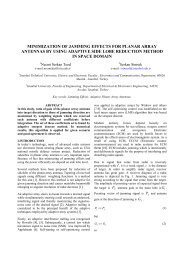Deregulation of the Power Industry in Europe
Deregulation of the Power Industry in Europe
Deregulation of the Power Industry in Europe
Create successful ePaper yourself
Turn your PDF publications into a flip-book with our unique Google optimized e-Paper software.
<strong>Deregulation</strong> <strong>of</strong> <strong>the</strong> <strong>Power</strong> <strong>Industry</strong> <strong>in</strong> <strong>Europe</strong><br />
Abstract-- This paper will present <strong>the</strong> past, <strong>the</strong> actual and <strong>the</strong><br />
future status <strong>of</strong> <strong>the</strong> deregulation activities <strong>in</strong> <strong>Europe</strong>. Briefly<br />
describe <strong>the</strong> deregulation process, <strong>in</strong>terconnections between <strong>the</strong><br />
different countries <strong>in</strong> <strong>Europe</strong>, <strong>the</strong> members <strong>of</strong> <strong>the</strong> <strong>Europe</strong>an<br />
Union, speak about <strong>the</strong> United K<strong>in</strong>gdom <strong>Power</strong> Pool market, <strong>the</strong><br />
different opportunities for some country, and at <strong>the</strong> end will be<br />
made some conclusions.<br />
Keywords-- <strong>Deregulation</strong>, <strong>Power</strong> System, <strong>Power</strong> Market.<br />
Jordan Shikoski 1 M.Sc., Dr Vladimir Katic 2 Ph.D.<br />
I. INTRODUCTION<br />
Historically, <strong>the</strong> cost <strong>of</strong> generat<strong>in</strong>g power decl<strong>in</strong>ed as<br />
utilities built ever-larger power plants, which <strong>in</strong>creased<br />
efficiency and reduced production costs. Utilities rout<strong>in</strong>ely<br />
requested rate reductions based on decl<strong>in</strong><strong>in</strong>g costs and <strong>in</strong> an<br />
effort to <strong>in</strong>crease electrical demand. Increased electric demand<br />
required more and larger plants, which reduced costs fur<strong>the</strong>r as<br />
well as <strong>in</strong>creas<strong>in</strong>g <strong>the</strong> utility rate base. This era was a w<strong>in</strong>-w<strong>in</strong><br />
for everyone. Consumers had abundant, low-cost power;<br />
regulators oversaw decl<strong>in</strong><strong>in</strong>g rates, <strong>in</strong>creased electrification,<br />
and economic growth; and utilities and stockholders ga<strong>in</strong>ed<br />
f<strong>in</strong>ancially. The 1970s and 1980s saw <strong>the</strong> launch<strong>in</strong>g <strong>of</strong> several<br />
trends that paved <strong>the</strong> way for electric utility deregulation. The<br />
first was <strong>the</strong> energy efficiency efforts result<strong>in</strong>g from <strong>the</strong> oil<br />
price shocks. Ris<strong>in</strong>g fuel prices hit <strong>the</strong> transportation <strong>in</strong>dustry<br />
especially hard. In response, eng<strong>in</strong>e manufacturers designed<br />
more fuel-efficient motors. The jet turb<strong>in</strong>e eng<strong>in</strong>e used by <strong>the</strong><br />
airl<strong>in</strong>e <strong>in</strong>dustry is identical to that used <strong>in</strong> peak<strong>in</strong>g power<br />
plants. Consequently, power plants based on <strong>the</strong>se new, aeroderivative<br />
turb<strong>in</strong>es had lower production costs than older<br />
designs, significantly so. Utility demand for natural gas as a<br />
generat<strong>in</strong>g fuel could not be satisfied at 1970 levels <strong>of</strong><br />
production ow<strong>in</strong>g to peculiarities <strong>in</strong> natural gas <strong>in</strong>dustry<br />
regulation. Solv<strong>in</strong>g this problem led to <strong>the</strong> second trend,<br />
deregulation. <strong>Deregulation</strong> <strong>of</strong> <strong>the</strong> natural gas <strong>in</strong>dustry paved<br />
<strong>the</strong> way for electric <strong>in</strong>dustry deregulation both by unleash<strong>in</strong>g<br />
market forces to free up natural gas for electricity generation.<br />
The deregulation <strong>of</strong> <strong>the</strong> power <strong>in</strong>dustry <strong>in</strong> <strong>Europe</strong> has started<br />
<strong>in</strong> 1990 with <strong>the</strong> open<strong>in</strong>g <strong>of</strong> <strong>the</strong> market <strong>in</strong> England and Wales.<br />
At this time, <strong>the</strong> English power market was <strong>the</strong> first to open <strong>in</strong><br />
<strong>Europe</strong> and it was a model for lot <strong>of</strong> countries all around <strong>the</strong><br />
world. After that, <strong>the</strong> Scand<strong>in</strong>avian market has progressively<br />
opened <strong>in</strong> 1991 (Norway), <strong>in</strong> 1995 (F<strong>in</strong>land) and 1996<br />
(Sweden). With <strong>the</strong> process for deregulation, private<br />
participation and competition are <strong>in</strong>troduced <strong>in</strong> power<br />
J. Shikoski is with A. D. EMO - Ohrid, P.O.Box 118, 6000 Ohrid,<br />
Macedonia (e-mail: jordans@mt.net.mk).<br />
V. Katic is with Faculty <strong>of</strong> Technical Sience, University <strong>of</strong> Novi<br />
Sad, Jugoslavija, 21000 Novi Sad (e-mail: katav@uns.ns.ac.yu).<br />
<strong>in</strong>dustry. The old model <strong>of</strong> power system is one <strong>of</strong> vertically<br />
<strong>in</strong>tegrated regulated monopoly compris<strong>in</strong>g <strong>the</strong> three elements:<br />
generation, transmission and distribution. In <strong>the</strong> new model,<br />
generation, transmission and distribution are treated<br />
separately, with generation and retail services set free from <strong>the</strong><br />
deregulation mechanism.<br />
II. INTERCONNECTIONS IN EUROPE<br />
Before any open market <strong>of</strong> deregulation, <strong>the</strong> electrical<br />
network <strong>in</strong> <strong>Europe</strong> was already highly developed. The<br />
reliability <strong>of</strong> <strong>the</strong> all network is improved. In case <strong>of</strong><br />
emergency, a neighbor can provide <strong>the</strong> necessary power to<br />
allow <strong>the</strong> cont<strong>in</strong>uity <strong>in</strong> <strong>the</strong> delivery. Moreover, some money<br />
can be saved by reduc<strong>in</strong>g <strong>the</strong> number <strong>of</strong> production units or by<br />
reduc<strong>in</strong>g <strong>the</strong> operat<strong>in</strong>g cost dur<strong>in</strong>g <strong>the</strong> peak loads. For example<br />
Switzerland (60% hydropower) needs power dur<strong>in</strong>g <strong>the</strong> night<br />
to do pump storage, Spa<strong>in</strong> needs a lot <strong>of</strong> power <strong>in</strong> summer due<br />
to air condition<strong>in</strong>g. There are 6 major groups <strong>of</strong><br />
<strong>in</strong>terconnections <strong>in</strong> <strong>Europe</strong>: UCTE, (Union for <strong>the</strong><br />
Coord<strong>in</strong>ation <strong>of</strong> Transmission <strong>of</strong> Electricity). It regroups<br />
companies from Belgium, Germany, Spa<strong>in</strong>, France, Greece,<br />
Italy, Slovenia, Croatia, Serbia, Macedonia, Bosnia and<br />
Herzegov<strong>in</strong>a, Luxembourg, Ne<strong>the</strong>rlands, Austria, Portugal and<br />
Switzerland. This networks ma<strong>in</strong>ly goes from North to South<br />
[2]; CENTREL, four countries from Central <strong>Europe</strong>: Poland,<br />
Czech Republic, Slovakia and Hungary. They have formed this<br />
organization to be separated from <strong>the</strong> Russian network. S<strong>in</strong>ce<br />
1999, <strong>the</strong>y are members <strong>of</strong> <strong>the</strong> UCTE; NORDEL, regroups <strong>the</strong><br />
Scand<strong>in</strong>avian companies, created <strong>in</strong> 1963: Denmark, F<strong>in</strong>land,<br />
Iceland, Norway, Sweden; UKTSOA, (United K<strong>in</strong>gdom<br />
Transmission System Operators Association); ATSOI,<br />
(Association <strong>of</strong> Transmission System Operators <strong>in</strong> Ireland);<br />
and UPS, (United <strong>Power</strong> System). It regroups <strong>the</strong> countries <strong>of</strong><br />
<strong>the</strong> former Soviet Union [4]. As said before, <strong>the</strong>se<br />
<strong>in</strong>terconnections between countries allow an exchange <strong>of</strong><br />
power. Moreover for companies like Electricite de France<br />
(EdF), <strong>the</strong> <strong>in</strong>terconnections already allow a real trade <strong>of</strong><br />
energy (even if this trade is desired and does not occur <strong>in</strong> a<br />
case <strong>of</strong> competition).. The figure 1 shows <strong>the</strong> different types <strong>of</strong><br />
connection. S<strong>in</strong>ce 1999, <strong>the</strong> eastern countries (countries from<br />
<strong>the</strong> CENTREL, Romania, Bulgaria, countries form UPS) have<br />
tried to jo<strong>in</strong> <strong>the</strong> UCTE. For <strong>the</strong> time be<strong>in</strong>g, only <strong>the</strong> countries<br />
from <strong>the</strong> CENTREL are associated members and are<br />
connected to <strong>the</strong> UCTE. Given that <strong>the</strong> eastern countries have<br />
more problems <strong>of</strong> reliability (even if <strong>the</strong> countries <strong>of</strong> <strong>the</strong><br />
CENTREL did a great job to jo<strong>in</strong> <strong>the</strong> UCTE), <strong>the</strong> exchange, at<br />
least for <strong>the</strong> time be<strong>in</strong>g, should be from West to East. Among<br />
<strong>the</strong> different groups (like UCTE, NORDEL), some countries<br />
have already experience <strong>the</strong> deregulation and have a full open<br />
electricity market.
ATSOI<br />
UKTSOA<br />
UCTE<br />
UPS CENTREL<br />
NORDEL<br />
: AC l<strong>in</strong>k : DC l<strong>in</strong>k<br />
Fig. 1: Interconnection <strong>of</strong> different groups <strong>in</strong> <strong>Europe</strong><br />
III. THE CASE OF THE EUROPEAN UNION<br />
S<strong>in</strong>ce a directive <strong>of</strong> <strong>the</strong> <strong>Europe</strong>an Union <strong>in</strong> 1995, adopted<br />
<strong>in</strong> 1996 by <strong>the</strong> <strong>Europe</strong>an M<strong>in</strong>ister Council, <strong>the</strong> <strong>Europe</strong>an<br />
electricity market has to open partially <strong>in</strong> 1999 (26.5%). This<br />
announces <strong>the</strong> end <strong>of</strong> state monopolies <strong>in</strong> this area. The<br />
directive foresee three different objectives:<br />
• The open<strong>in</strong>g to <strong>the</strong> competition <strong>in</strong> three steps: ‘99: 26,5%<br />
<strong>of</strong> each national market; ‘00: 30% <strong>of</strong> each national market;<br />
• The possibility for anyone to build a power plant and to<br />
have access to <strong>the</strong> transmission and distribution networks.<br />
• A neutral and <strong>in</strong>dependent electrical network.<br />
These rules have to be applied by each country <strong>of</strong> <strong>the</strong><br />
<strong>Europe</strong>an Union [10]. Never<strong>the</strong>less, a lot <strong>of</strong> countries <strong>of</strong> <strong>the</strong><br />
Union are beh<strong>in</strong>d schedule. Countries like Ireland, Belgium,<br />
France and Greece received one year <strong>of</strong> derogation.<br />
TABLE 1. THE ELECTRICITY PRODUCERS IN THE EUROPEAN UNION.<br />
SOURCE EDF PUBLISHED IN A REPORT OF THE FRENCH SENATE [11]<br />
Country Producer<br />
% <strong>of</strong> national<br />
market<br />
Austria Vrebund, Regional comp. 46, 31<br />
Belgium Electrabel (private comp.) 95<br />
Denmark 8 producers process by dist.<br />
F<strong>in</strong>land IVO, PVO, Municipal comp. 37, 23, 21<br />
France EdF 95<br />
Germany 9 “biggest” 81<br />
Greece DEH 98<br />
Italy ENEL, Independent 78, 18<br />
Ireland ESB -<br />
Luxembourg Import 98<br />
Ne<strong>the</strong>rlands 4 regional producers 65<br />
Portugal CPPE<br />
United<br />
National <strong>Power</strong>, <strong>Power</strong> Gen, 21, 20,<br />
K<strong>in</strong>gdom British Energy<br />
17<br />
Spa<strong>in</strong> ENDESA, Iberdrola 52, 33<br />
Sweden Vattenfall, Skydraft 50, 21<br />
This delay can be due some technical difficulties or<br />
political issues. Each country has to adopt <strong>the</strong> <strong>Europe</strong>an<br />
directives and to put <strong>the</strong>m <strong>in</strong> <strong>the</strong>ir national laws. Moreover for<br />
a lot <strong>of</strong> countries, <strong>the</strong> electricity market is a state-owned<br />
monopoly. The table 1 shows <strong>the</strong> producers <strong>of</strong> electricity <strong>in</strong><br />
<strong>Europe</strong>. It is obvious that for <strong>the</strong> countries that are not yet<br />
deregulated, <strong>the</strong> production is entirely dom<strong>in</strong>ated by <strong>the</strong><br />
national producer (more than 90% <strong>of</strong> <strong>the</strong> production). See<strong>in</strong>g<br />
its own market open has scared a lot <strong>of</strong> countries and <strong>the</strong>y<br />
could to protect and tra<strong>in</strong> <strong>the</strong> national company. For example,<br />
<strong>in</strong> France, EdF (with 95% <strong>of</strong> <strong>the</strong> French market) dom<strong>in</strong>ates <strong>the</strong><br />
production, and <strong>the</strong> transmission and <strong>the</strong> distribution networks<br />
belong to it. That is why EdF will <strong>of</strong> course follow <strong>the</strong><br />
<strong>Europe</strong>an directive but it will follow it strictly. Never<strong>the</strong>less<br />
this open<strong>in</strong>g will be applied to everybody, which means that it<br />
could be an opportunity for each company. One <strong>of</strong> <strong>the</strong> problem<br />
<strong>of</strong> <strong>the</strong> <strong>Europe</strong>an directive is that it does not specify how <strong>the</strong><br />
market has to be regulated which means, that each country can<br />
choose its own way to open its market. Some <strong>of</strong> <strong>the</strong>m will<br />
follow <strong>the</strong> English model, some <strong>the</strong> Nordic one. Thus, <strong>the</strong><br />
market will be open, but it will not have a unity.<br />
The latest announcement from EC, on 12 March 2001 is<br />
that electricity market <strong>of</strong> its member states should be fully<br />
open to competition by January 2005. Is <strong>the</strong> member states<br />
ready? Is that will be one <strong>of</strong> <strong>the</strong> major requirements for <strong>the</strong><br />
new members? The situation does not have to get worse before<br />
it gets better.<br />
IV. THE HISTORY OF THE UK DEREGULATED POWER SYSTEMS<br />
AND ITS POOL<br />
The power system <strong>of</strong> <strong>the</strong> United K<strong>in</strong>gdom (UK) and<br />
California are two typical deregulated systems that have been<br />
used. The Pool type <strong>of</strong> deregulated power systems has been<br />
used <strong>in</strong> <strong>the</strong> UK and <strong>the</strong> ISO (Independent System Operator)<br />
type <strong>of</strong> deregulated power systems has been used <strong>in</strong> <strong>the</strong> United<br />
States. The UK electricity pool suppose to be a good example<br />
<strong>of</strong> how deregulation is work<strong>in</strong>g. This simplified model <strong>of</strong><br />
restructur<strong>in</strong>g is also used similarly <strong>in</strong> some o<strong>the</strong>r countries,<br />
such as Brazil, S<strong>in</strong>gapore, Australia and Argent<strong>in</strong>a. It is not<br />
<strong>in</strong>tended to show a detailed explanation <strong>of</strong> <strong>the</strong> UK pool,<br />
<strong>in</strong>stead economical and ma<strong>the</strong>matical issues are reduced to a<br />
m<strong>in</strong>imum. A brief explanation <strong>of</strong> <strong>the</strong> relevant topics is<br />
presented with <strong>the</strong> <strong>in</strong>tention <strong>of</strong> br<strong>in</strong>g<strong>in</strong>g general idea <strong>of</strong> how<br />
this pool was implemented, which is sufficient for <strong>the</strong><br />
objectives <strong>of</strong> this paper. After <strong>the</strong> UK Electricity Act <strong>of</strong> 1989,<br />
<strong>the</strong> restructur<strong>in</strong>g <strong>of</strong> <strong>the</strong> power system started. The structure <strong>of</strong><br />
<strong>the</strong> UK electric power system after deregulation is shown <strong>in</strong><br />
figure 2. After deregulation, <strong>the</strong> former Central Electricity<br />
Generat<strong>in</strong>g Board is restructured <strong>in</strong>to four separate<br />
organizations: two power producers, a transmission company,<br />
and a distribution network consist<strong>in</strong>g <strong>of</strong> twelve regional<br />
electricity companies (RECs). Each organization participates<br />
one <strong>the</strong> four progresses: generation, transmission, distribution<br />
and market<strong>in</strong>g. In <strong>the</strong> UK, generation is deemed an area where<br />
a competitive market could develop most successful. No<br />
specific price regulation was <strong>in</strong>itially <strong>in</strong>tended for generation,<br />
as <strong>the</strong> national wholesale power pool is <strong>in</strong>tended to produce<br />
market based price. The UK's transmission system is a natural<br />
monopoly. The transmission is imposed periodic price reviews<br />
and price caps based on changes <strong>in</strong> <strong>the</strong> overall rate <strong>of</strong> <strong>in</strong>flation.<br />
The distribution companies are allowed to acquire generation<br />
assets with <strong>the</strong> restriction that no REC generation facilities<br />
account for more than 15 % <strong>of</strong> <strong>the</strong>ir <strong>in</strong>dividual electricity sales.<br />
This action was taken <strong>in</strong> order to <strong>in</strong>troduce more competition<br />
<strong>in</strong> generation. The market<strong>in</strong>g is <strong>the</strong> last part to be deregulated.<br />
Large users are allowed to choose <strong>the</strong>ir marketers, as opposed<br />
to be<strong>in</strong>g required to purchase electricity from <strong>the</strong>ir REC. The<br />
small <strong>in</strong>dustrial and commercial companies and residential<br />
users are also under this way.
National<br />
<strong>Power</strong><br />
<strong>Power</strong>gen<br />
Independent<br />
Generators<br />
Magnox<br />
Electric<br />
O<strong>the</strong>rs British<br />
Energy<br />
N a t i o n a l E l e c t r i c i t y G r i d a n d P o o l<br />
Regional Electricity<br />
Companies<br />
Small Users<br />
(100 kW)<br />
A year 1989, Stephen Littlechild, a Brim<strong>in</strong>gham University<br />
pr<strong>of</strong>essor, <strong>in</strong>stituted <strong>the</strong> <strong>Power</strong> Pool bidd<strong>in</strong>g system that was<br />
supposed to lower prices for electricity. The Pool executive<br />
committee has ten members; three are from major generators,<br />
two are representatives <strong>of</strong> smaller generators, one is an<br />
<strong>in</strong>dependent retailer, and four represent twelve <strong>of</strong> <strong>the</strong> regional<br />
electricity companies. A chief executive adm<strong>in</strong>isters <strong>the</strong> pool<br />
on a daily basis. The UK pool rules def<strong>in</strong>e <strong>the</strong> trad<strong>in</strong>g<br />
arrangements between pool members. The pool acts as a<br />
hold<strong>in</strong>g account for energy purchased from several sources on<br />
behalf <strong>of</strong> <strong>the</strong> customers. The UK pool rules that def<strong>in</strong>e <strong>the</strong><br />
transactions between members are extensive and complexly<br />
expressed by several formulas; <strong>the</strong>refore only an abstract <strong>of</strong><br />
some rules will be listed:<br />
• The production is established for <strong>the</strong> next day, accord<strong>in</strong>g<br />
to <strong>the</strong> forecast <strong>of</strong> <strong>the</strong> NGC.<br />
• An economic dispatch, named U-schedule (U,<br />
unconstra<strong>in</strong>ed), based on <strong>the</strong> demand forecast is executed.<br />
• For every half-hour “system marg<strong>in</strong>al price” (SMP) is<br />
determ<strong>in</strong>ed; which corresponds to <strong>the</strong> highest <strong>in</strong>cremental<br />
cost among <strong>the</strong> generators <strong>in</strong>cluded <strong>in</strong> U-schedule.<br />
• Reserve capacity <strong>of</strong>fered by generators is later<br />
recompensed <strong>in</strong> <strong>the</strong> process.<br />
• The next day (planned day), NGC <strong>in</strong>forms each generator<br />
about <strong>the</strong> time and level <strong>of</strong> generation needed.<br />
• The deviation <strong>of</strong> power generated from <strong>the</strong> executed Uschedule<br />
is purchase or sold by <strong>the</strong> pool at each generator<br />
<strong>in</strong>cremental cost. Unavailable generation that was <strong>of</strong>fered<br />
<strong>the</strong> day before is penalized.<br />
• At <strong>the</strong> end <strong>of</strong> <strong>the</strong> transactions, <strong>the</strong> pool-sell<strong>in</strong>g price (PSP)<br />
is calculated, and this is <strong>the</strong> price <strong>of</strong>fered to <strong>the</strong> customers.<br />
A forward sale is a transaction between buyers and sellers<br />
arranged one day <strong>in</strong> advance. In this type <strong>of</strong> transaction, <strong>the</strong><br />
buyer agrees to deliver power, for periods <strong>of</strong> thirty m<strong>in</strong>utes, at<br />
a certa<strong>in</strong> price and time <strong>of</strong> <strong>the</strong> day, based on <strong>the</strong> U-schedules.<br />
Such a price, def<strong>in</strong>es <strong>the</strong> pool purchase price (PPP), see fig. 3.<br />
Option contracts can also be set <strong>in</strong> advance. They give <strong>the</strong><br />
holder <strong>the</strong> right to negotiate power only if it wishes. The terms<br />
<strong>of</strong> <strong>the</strong> contract <strong>in</strong>clude time and place <strong>of</strong> delivery, and <strong>the</strong><br />
price, which is known as <strong>the</strong> "strike price". This type <strong>of</strong><br />
transaction is def<strong>in</strong>ed as <strong>the</strong> "option fee", which is a fixed<br />
O<strong>the</strong>r Licensed<br />
Suppliers<br />
Electricity<br />
de France<br />
Fig. 2: Structure <strong>of</strong> UK Electric <strong>Power</strong> System<br />
British Nuclear<br />
<strong>Power</strong><br />
Generators/<br />
Suppliers<br />
Small Users<br />
(100 kW)<br />
price. It reflects <strong>the</strong> expected value to <strong>the</strong> holder <strong>of</strong> be<strong>in</strong>g able<br />
to negotiate power at <strong>the</strong> strike price, given that <strong>the</strong> spot<br />
market price may be higher or lower at <strong>the</strong> time <strong>of</strong> delivery. In<br />
o<strong>the</strong>r words, <strong>the</strong> pool pays <strong>the</strong> generators an option fee for<br />
reserve capacity. If <strong>the</strong> pool requests <strong>the</strong> next day to generate<br />
such reserves, it is paid at <strong>the</strong> strike price. Spot purchase<br />
transaction, which is characterized by immediate delivery <strong>of</strong><br />
<strong>the</strong> product, with <strong>the</strong> price vary<strong>in</strong>g to equilibrate supply and<br />
demand. Many spot transactions are made to avoid previous<br />
contracts, and to remove <strong>the</strong> obligation to deliver by a<br />
compensat<strong>in</strong>g deal. Reasons that could make a deal to be<br />
neutralized are those such as transmission constra<strong>in</strong>ts,<br />
overestimated demands, lack or excess <strong>of</strong> generation <strong>in</strong><br />
comparison to <strong>the</strong> U-schedule and emergencies. The PPP is<br />
<strong>in</strong>tended to reflect <strong>the</strong> expected value <strong>of</strong> <strong>the</strong> spot market price.<br />
When <strong>the</strong> demand is lower than <strong>the</strong> generation capacity, <strong>the</strong><br />
cost <strong>of</strong> extra supplies would be given by a spot transaction, at<br />
<strong>the</strong> highest price <strong>of</strong> any generator <strong>in</strong> <strong>the</strong> system. When <strong>the</strong><br />
demand is higher than <strong>the</strong> generation capacity, supply and<br />
demand could be balanced only by rais<strong>in</strong>g <strong>the</strong> price up to a<br />
po<strong>in</strong>t where customers would prefer to reduce <strong>the</strong>ir demand.<br />
This price is known as <strong>the</strong> "value <strong>of</strong> lost load" (VOLL). The<br />
probability that <strong>the</strong> demand will exceed capacity is known as<br />
<strong>the</strong> "loss <strong>of</strong> load probability" (LOLP), and <strong>the</strong> probability <strong>of</strong><br />
meet<strong>in</strong>g load from available generation is <strong>the</strong>n one m<strong>in</strong>us<br />
LOLP. Then, <strong>the</strong> PPP is adjusted at die probability-weighted<br />
average <strong>of</strong> <strong>the</strong> prices <strong>in</strong> <strong>the</strong> two possible cases.<br />
PPP = [(1-LOLP) x SMP] + [LOLP x VOLL]<br />
Transactions at <strong>the</strong> customer side are simpler, NGC estimates<br />
<strong>the</strong> amount <strong>of</strong> energy <strong>the</strong>y will require. The extra costs <strong>of</strong><br />
energy above <strong>the</strong> PPP, <strong>in</strong>clud<strong>in</strong>g those from transmission<br />
constra<strong>in</strong>s on <strong>the</strong> National Grid, are simply lumped toge<strong>the</strong>r <strong>in</strong><br />
what is known as “uplift”, and divided among all <strong>the</strong> energy<br />
taken by customers. This leads to <strong>the</strong> calculation <strong>of</strong> a s<strong>in</strong>gle<br />
consumer price, <strong>the</strong> pool sell<strong>in</strong>g price (PSP): PSP = PPP +<br />
uplift.
GenCo1<br />
GenCo2<br />
Forward sales based on <strong>the</strong> U-schedule<br />
Pool Purchase Price<br />
GenCo3<br />
Spot<br />
purchase<br />
A. Brita<strong>in</strong> <strong>Power</strong> POOL, Not a Model to Follow<br />
A couple years ago an <strong>in</strong>vestigation <strong>of</strong> <strong>the</strong> <strong>Power</strong> Pool<br />
market performances, lead to <strong>the</strong> conclusions that <strong>the</strong>re is a<br />
strong evidence that Pool prices were be<strong>in</strong>g manipulated; that<br />
participants <strong>in</strong> <strong>the</strong> pool have been us<strong>in</strong>g rules for <strong>the</strong>ir<br />
commercial <strong>in</strong>terests; and that higher wholesale prices have<br />
been established that will mean higher prices for customers.<br />
And this manipulation has been accelerat<strong>in</strong>g. Unfortunately<br />
Brita<strong>in</strong>’s <strong>Power</strong> Pool model was a model for restructur<strong>in</strong>g<br />
around <strong>the</strong> world, <strong>in</strong>clud<strong>in</strong>g <strong>in</strong> some states <strong>in</strong> <strong>the</strong> United States.<br />
The model supposed to reduce prices for consumers. Even as<br />
<strong>the</strong> United States has moved to deregulate wholesale electricity<br />
prices and taken steps <strong>in</strong> some states toward market pric<strong>in</strong>g <strong>of</strong><br />
retail sales, some major difference between <strong>the</strong> restructured<br />
electric systems <strong>in</strong> Brita<strong>in</strong> and US rema<strong>in</strong>s:<br />
• In <strong>the</strong> U S, stakeholders participate fully <strong>in</strong> <strong>the</strong> process.<br />
• Instead <strong>of</strong> be<strong>in</strong>g allowed to claim that cost data<br />
confidential and not to be shared, U S electric companies<br />
must provide <strong>in</strong>formation to <strong>the</strong> regulators and to <strong>the</strong><br />
public that will allow “just and reasonable” rates to be<br />
determ<strong>in</strong>ed<br />
In Brita<strong>in</strong> democratic regulation is a contradiction <strong>in</strong> terms.<br />
The high and volatile prices <strong>in</strong>herent <strong>in</strong> unfettered markets will<br />
becomes a feature <strong>of</strong> <strong>the</strong> United States electric <strong>in</strong>dustry as<br />
well-unless public participation and transparency <strong>of</strong><br />
<strong>in</strong>formation cont<strong>in</strong>ue to be standard practice <strong>in</strong> <strong>the</strong> pric<strong>in</strong>g <strong>of</strong><br />
electricity.<br />
B. Transform<strong>in</strong>g <strong>the</strong> Brita<strong>in</strong> <strong>Power</strong> POOL<br />
After just about a decade <strong>of</strong> high prices and market<br />
manipulations, bidd<strong>in</strong>g zero <strong>in</strong>to <strong>the</strong> pool to ensure schedul<strong>in</strong>g,<br />
and <strong>the</strong>n be<strong>in</strong>g paid a price higher than <strong>the</strong> pool median,<br />
Brita<strong>in</strong> spend an additional £100 million to elim<strong>in</strong>ate <strong>the</strong><br />
<strong>Power</strong> Pool, October 1998, and <strong>in</strong>stitute <strong>the</strong> New Electricity<br />
Trad<strong>in</strong>g Arrangements (NETA). The New NETA were<br />
expected to be activated <strong>in</strong> March 2001. The primary tenets <strong>of</strong><br />
NETA are: forwards and futures markets, allow<strong>in</strong>g contracts to<br />
be agreed upon for years ahead or day to day; balanc<strong>in</strong>g<br />
system adm<strong>in</strong>istered by <strong>the</strong> National Greed Company (NGC);<br />
settlement process for recoup<strong>in</strong>g system operator costs.<br />
Unlike <strong>the</strong> <strong>Power</strong> Pool model, where power was centrally<br />
dispatched (similar to California’s system except that head<strong>in</strong>g–<br />
bay<strong>in</strong>g power on <strong>the</strong> futures market to “hadge” aga<strong>in</strong>st prices<br />
ris<strong>in</strong>g–was allowed), NETA allows self-dispatch<strong>in</strong>g, which<br />
allows <strong>the</strong> generator companies to send out power as <strong>the</strong>y see<br />
Option<br />
called<br />
Average cost per kWh generated<br />
GenCon<br />
Option<br />
fee<br />
Fig. 3: United K<strong>in</strong>gdom Pool transaction under deregulation<br />
POOL<br />
Sell<strong>in</strong>g<br />
price<br />
Customer<br />
feet. But we have to remember that NETA just put <strong>in</strong> place on<br />
27 March 2001, is too soon to know whe<strong>the</strong>r it will foster<br />
competition and lower consumer prices.<br />
V. THE CASE OF THE SCANDINAVIAN COUNTRIES<br />
In 1991, Norway started to deregulate its electricity market.<br />
That is why, <strong>in</strong> 1995, F<strong>in</strong>land did <strong>the</strong> same and has been<br />
followed by Sweden <strong>in</strong> 1996. Nowadays, <strong>the</strong> entire power<br />
market <strong>of</strong> Norway, Sweden and F<strong>in</strong>land is open. By <strong>the</strong> end <strong>of</strong><br />
year 2002, <strong>the</strong> entire Danish market will open too. The<br />
NORDEL common market is called <strong>the</strong> Nord Pool. The goal<br />
<strong>of</strong> this open<strong>in</strong>g is clearly to give advantages to <strong>the</strong> customers.<br />
Thus, <strong>the</strong>y created both a physical power market (Elspot) and<br />
a f<strong>in</strong>ancial power market (Elderion). Elspot market is <strong>the</strong> ma<strong>in</strong><br />
market <strong>in</strong> which <strong>the</strong> power is really traded. This market<br />
organizes <strong>the</strong> production for <strong>the</strong> next day. The production is<br />
scheduled day by day. The auctions that place <strong>in</strong> this market<br />
are done with sealed bids, which meals that <strong>the</strong> bids from <strong>the</strong><br />
producers and <strong>the</strong> customers are first received (anonymously)<br />
and <strong>the</strong>n <strong>the</strong> price is established at <strong>the</strong> equilibrium <strong>of</strong> <strong>the</strong><br />
supply and <strong>of</strong>fer (and here, <strong>the</strong> grid capacity is taken <strong>in</strong><br />
account). People can only propose bids for <strong>the</strong>ir own area. The<br />
grid companies <strong>of</strong> Norway and Sweden possess <strong>the</strong> Nord Pool<br />
market, never<strong>the</strong>less, <strong>the</strong> F<strong>in</strong>land Grid Company is highly<br />
considered because <strong>of</strong> <strong>the</strong> capacity problems that can occur <strong>in</strong><br />
F<strong>in</strong>land. Given that <strong>the</strong> balance can not exactly exist between<br />
production and consumption, a second power market (Elbas<br />
market for Sweden and F<strong>in</strong>land, Regulat<strong>in</strong>g <strong>Power</strong> Market <strong>in</strong><br />
Norway) allows trades hour by hour this up to two hours<br />
before deliver<strong>in</strong>g <strong>the</strong> power. But if people do not want to use<br />
this market, <strong>the</strong>y can directly have a bilateral contract with a<br />
producer. In this direction, a f<strong>in</strong>ancial power market has also<br />
been created to allow people to buy <strong>the</strong> type <strong>of</strong> contracts <strong>the</strong>y<br />
want, for <strong>the</strong> time <strong>the</strong>y want (day, week, month, season) and at<br />
<strong>the</strong> supplier <strong>the</strong>y want. To allow good transactions without any<br />
problems, <strong>the</strong> banks <strong>of</strong> <strong>the</strong> buyers have to certify each<br />
transaction. For this goal, ano<strong>the</strong>r component called <strong>the</strong><br />
Nordic Electricity Clear<strong>in</strong>g (NEC) has <strong>the</strong> goal <strong>of</strong> <strong>in</strong>sur<strong>in</strong>g <strong>the</strong><br />
trade [8] and [9].<br />
VI. THE CASE OF THE RUSSIA<br />
In reality, <strong>the</strong> Russian wholesale market is divided <strong>in</strong>to<br />
several large regions due to <strong>the</strong> high cost <strong>of</strong> electricity<br />
transmission and <strong>the</strong> constra<strong>in</strong>ts <strong>in</strong> <strong>the</strong> Russian transmission
network: <strong>the</strong> <strong>Europe</strong>an part <strong>of</strong> Russia, Siberia, and <strong>the</strong> Russian<br />
Far East. The structure <strong>of</strong> <strong>the</strong> economy, <strong>the</strong> power <strong>in</strong>dustry,<br />
and climate conditions <strong>in</strong> <strong>the</strong>se regions are quite different.<br />
These circumstances cause additional problems <strong>in</strong><br />
implement<strong>in</strong>g a nation-wide model <strong>of</strong> <strong>the</strong> wholesale<br />
competitive market. Therefore, <strong>the</strong> federal wholesale<br />
electricity and capacity market <strong>in</strong> Russia will have some<br />
differences <strong>in</strong> <strong>the</strong> three large regions. In <strong>the</strong> <strong>Europe</strong>an region<br />
<strong>of</strong> Russia, a competitive electricity and capacity market, is<br />
feasible if several generat<strong>in</strong>g companies are created. A new<br />
project on <strong>the</strong> electric power <strong>in</strong>dustry restructur<strong>in</strong>g has been<br />
proposed recently by Russian Jo<strong>in</strong>t-Stock Company, RJSC,<br />
“UPS <strong>of</strong> Russia”. The project is presently under discussion <strong>in</strong><br />
<strong>the</strong> country. The follow<strong>in</strong>g transformations are proposed by<br />
<strong>the</strong> project:<br />
• All power plants are to be separated from local power<br />
utilities and transformed <strong>in</strong>to new jo<strong>in</strong>t-stock companies.<br />
Two affiliated companies <strong>of</strong> RJSC "UPS <strong>of</strong> Russia" will<br />
be created for management <strong>of</strong> <strong>the</strong>rmal and hydro power<br />
plants. Thus, electricity generation will be separated from<br />
local power utilities.<br />
• The competition among electricity producers is supposed<br />
to <strong>in</strong>crease. Market pr<strong>in</strong>ciples <strong>of</strong> pric<strong>in</strong>g will be<br />
<strong>in</strong>troduced <strong>in</strong>to <strong>the</strong> generation bus<strong>in</strong>ess. Generation<br />
pric<strong>in</strong>g will be withdrawn from state regulation.<br />
• RJSC “UPS <strong>of</strong> Russia” for transmission network operation<br />
and development will establish an affiliated transmission<br />
company. Prices <strong>of</strong> transmission service will rema<strong>in</strong><br />
regulated.<br />
• RJSC "UPS <strong>of</strong> Russia" will create an affiliated company<br />
for delivery <strong>of</strong> electricity to large <strong>in</strong>dustrial consumers.<br />
Local distribution companies affiliated with local power<br />
utilities are responsible for <strong>the</strong> electricity supply to o<strong>the</strong>r<br />
consumers [17].<br />
VII. THE CASE OF THE POLAND<br />
Currently, <strong>the</strong> pace <strong>of</strong> privatization <strong>in</strong> Poland's power sector<br />
won't change significantly, despite pressure from <strong>the</strong><br />
government for a slowdown. The treasury will cont<strong>in</strong>ue its<br />
policy <strong>of</strong> privatiz<strong>in</strong>g power generators and distributors <strong>in</strong><br />
tandem. The Economy M<strong>in</strong>istry opposes this strategy because<br />
it fears rapid sales <strong>of</strong> power distributors will damage <strong>the</strong><br />
prospects <strong>of</strong> generators and <strong>the</strong> unpr<strong>of</strong>itable coal-m<strong>in</strong><strong>in</strong>g<br />
sectors. The privatization <strong>of</strong> eight power distributors <strong>in</strong><br />
nor<strong>the</strong>rn Poland should be completed by Sept. 30, 2001[16].<br />
VIII. THE CASE OF THE GREECE<br />
Greece’s state-owned energy producer Public <strong>Power</strong> Corp.<br />
(PPC) is expected to go public <strong>in</strong> <strong>the</strong> first half <strong>of</strong> 2001, but it<br />
did not happened up to now. The government will reta<strong>in</strong> <strong>the</strong><br />
majority stake and <strong>the</strong> management <strong>of</strong> PPC. Part <strong>of</strong> PPC's<br />
preparation for enter<strong>in</strong>g <strong>the</strong> stock market is <strong>the</strong> reschedul<strong>in</strong>g <strong>of</strong><br />
its external debt [16].<br />
IX. THE CASE OF THE YUGOSLAVIA<br />
At <strong>the</strong> beg<strong>in</strong>n<strong>in</strong>g <strong>of</strong> n<strong>in</strong>eties former SFR Yugoslavia has split<br />
<strong>in</strong>to five new states - Slovenia, Croatia, Bosnia and<br />
Herzegov<strong>in</strong>a, Macedonia and FR Yugoslavia (Serbia &<br />
Montenegro). Unfortunately, <strong>the</strong> dissolution <strong>of</strong> Yugoslavia<br />
was accompanied by an armed conflict <strong>in</strong> Croatia and Bosnia,<br />
and f<strong>in</strong>ally with NATO bomb<strong>in</strong>g <strong>of</strong> FR Yugoslavia. Once<br />
unique electric power system, connected to <strong>Europe</strong>an grid -<br />
UCPT, broke <strong>in</strong>to several small systems, fur<strong>the</strong>r destroyed by<br />
war and especially by NATO, target<strong>in</strong>g <strong>the</strong> electric<br />
transmission system. Because <strong>of</strong> that, although FR Yugoslavia<br />
managed to repair its power electric system <strong>in</strong> a relatively<br />
short period <strong>of</strong> <strong>the</strong> time, <strong>in</strong>stead <strong>of</strong> deregulation, process <strong>of</strong><br />
recover<strong>in</strong>g and reconstruct<strong>in</strong>g is on <strong>the</strong> scene. State owned<br />
<strong>Power</strong> Electric Company <strong>of</strong> Serbia is now <strong>in</strong> transition to<br />
better and more efficient organization. At this moment process<br />
<strong>of</strong> privatization and organiz<strong>in</strong>g a market is a plan for future.<br />
X. THE CASE OF THE MACEDONIA<br />
The ESM is closely follow<strong>in</strong>g <strong>the</strong> restructur<strong>in</strong>g and<br />
privatization processes all around <strong>Europe</strong>. It is already<br />
identified that <strong>the</strong> needs for restructur<strong>in</strong>g <strong>of</strong> <strong>the</strong> current<br />
monopoly are necessary to improve <strong>the</strong> overall performance<br />
and cash flow <strong>of</strong> <strong>the</strong> ESM and <strong>the</strong> entire energy sector <strong>in</strong> <strong>the</strong><br />
country. For that purpose, few renowned foreign consult<strong>in</strong>g<br />
companies have already prepared several restructur<strong>in</strong>g and<br />
privatization strategies for ESM. Additionally, hav<strong>in</strong>g <strong>in</strong> m<strong>in</strong>d<br />
that ESM has to operate <strong>in</strong> <strong>the</strong> common EU and Balkan<br />
Electricity Market, <strong>the</strong> restructur<strong>in</strong>g <strong>of</strong> ESM must be done <strong>in</strong><br />
<strong>the</strong> strong correlation with <strong>the</strong> EU Directives, especially<br />
Directive 96/92. A special Committee for Restructur<strong>in</strong>g <strong>of</strong><br />
ESM was established with ma<strong>in</strong> task to def<strong>in</strong>e <strong>the</strong> frameworks<br />
for future transformation and restructur<strong>in</strong>g <strong>of</strong> ESM. Tak<strong>in</strong>g<br />
<strong>in</strong>to account <strong>the</strong> size, <strong>the</strong> current structure <strong>of</strong> <strong>the</strong> sources, fuels,<br />
transmission network and <strong>the</strong> large number <strong>of</strong> <strong>the</strong> exist<strong>in</strong>g<br />
distribution companies, it is envisaged that <strong>the</strong> best option for<br />
restructur<strong>in</strong>g <strong>of</strong> ESM is its organization as a Vertically<br />
Integrated Company with different accounts for production,<br />
transmission and distribution <strong>of</strong> <strong>the</strong> electricity. Transformation<br />
<strong>of</strong> ESM <strong>in</strong>to a Hold<strong>in</strong>g Company with various production<br />
branches is also one <strong>of</strong> <strong>the</strong> possible solutions for improv<strong>in</strong>g <strong>the</strong><br />
bus<strong>in</strong>ess effects <strong>of</strong> <strong>the</strong> company. For <strong>the</strong> privatization<br />
purposes, ESM toge<strong>the</strong>r with <strong>the</strong> German Consult<strong>in</strong>g<br />
Company CONSULECTRA developed a Master Plan, which<br />
will be used as a model document dur<strong>in</strong>g <strong>the</strong> com<strong>in</strong>g<br />
privatization. The tender for selection <strong>of</strong> <strong>the</strong> so-called<br />
Promoter or Consultant for <strong>the</strong> privatization with task to assist<br />
ESM and <strong>the</strong> Government <strong>of</strong> Macedonia through <strong>the</strong><br />
privatization process, has already been carried out. As a first<br />
step toward privatization, ESM <strong>in</strong>itiated its transformation<br />
from Public Enterprise <strong>in</strong>to <strong>the</strong> Jo<strong>in</strong>t Stock Company with 100<br />
% <strong>of</strong> <strong>the</strong> shares owned by <strong>the</strong> Government. F<strong>in</strong>ally, as one <strong>of</strong><br />
<strong>the</strong> necessary conditions for successful privatization <strong>of</strong> ESM, it<br />
is establish<strong>in</strong>g <strong>of</strong> so-called Regulatory Commission or Agency<br />
which will be responsible for issu<strong>in</strong>g electricity licenses,<br />
def<strong>in</strong>ition <strong>of</strong> <strong>the</strong> tariff structure for production, transmission<br />
and distribution <strong>of</strong> <strong>the</strong> electricity, and for sett<strong>in</strong>g all k<strong>in</strong>d <strong>of</strong><br />
disputes between parties <strong>in</strong> <strong>the</strong> fully liberalized electricity<br />
market <strong>in</strong> <strong>the</strong> Macedonia and wider. The first draft documents<br />
for establish<strong>in</strong>g <strong>of</strong> <strong>the</strong> Regulatory Agency are already prepared<br />
by <strong>the</strong> American Consult<strong>in</strong>g Company, Pierce & Atwood.
Hav<strong>in</strong>g all said above <strong>in</strong> m<strong>in</strong>d, one can see that ESM<br />
strongly committed itself to move <strong>in</strong> <strong>the</strong> direction <strong>of</strong><br />
establish<strong>in</strong>g a new market oriented power company which will<br />
be strong partner to <strong>the</strong> neighbor<strong>in</strong>g power companies <strong>in</strong> near<br />
future. With <strong>the</strong> help and support from <strong>the</strong> Government, it is<br />
estimated that <strong>the</strong> Macedonian energy market will be 30 %<br />
liberalized by 2003, and fully liberalized by 2006, for which<br />
Macedonia already signed a Protocol with all neighbor<strong>in</strong>g<br />
countries on September 1999, <strong>in</strong> Thessalonica, Greece.<br />
XI. THE CASE OF THE BULGARIA<br />
Bulgaria's energy sector is not yet strong enough to face<br />
competition from foreign suppliers and will rema<strong>in</strong> closed at<br />
least for <strong>the</strong> time be<strong>in</strong>g to allow domestic players to get used<br />
to <strong>the</strong> liberalization market conditions. In a statement, <strong>the</strong><br />
government said it would allow some local power and gas<br />
consumers to sign delivery contracts and negotiate prices with<br />
local producers as a first step towards a long-delayed<br />
privatization process. An <strong>of</strong>ficial from <strong>the</strong> state Energy<br />
Regulation Commission told <strong>the</strong> Reuters news agency, "We do<br />
not plan to allow domestic power and gas consumers to sign<br />
contracts with foreign producers. Our market is still very weak<br />
and will rema<strong>in</strong> closed for foreigners for now." Bulgaria is<br />
seek<strong>in</strong>g to jo<strong>in</strong> <strong>the</strong> <strong>Europe</strong>an Union but has faced criticism<br />
from <strong>the</strong> Commission and <strong>the</strong> International Monetary fund<br />
over <strong>the</strong> slow pace <strong>of</strong> reform <strong>in</strong> <strong>the</strong> energy sector. In 1998, <strong>the</strong><br />
Bulgarian parliament began to liberalize <strong>the</strong> country's power<br />
sector by unbundl<strong>in</strong>g <strong>the</strong> generation, transmission, and<br />
distribution activities <strong>of</strong> <strong>the</strong> national electricity company,<br />
NEK. In <strong>the</strong> summer <strong>of</strong> 2000, <strong>the</strong> largest power plants and<br />
distribution networks, <strong>in</strong>clud<strong>in</strong>g <strong>the</strong> country's Kozloduy<br />
nuclear power plant, were separated from NEK, creat<strong>in</strong>g seven<br />
generation and seven distribution companies. Six <strong>of</strong> <strong>the</strong> seven<br />
<strong>in</strong>dependent power generators registered a pr<strong>of</strong>it <strong>in</strong> 2000, and<br />
some <strong>of</strong> <strong>the</strong>m (but not Kozloduy) will be eligible for<br />
privatization. The government plans to sell its seven power<br />
distributors by <strong>the</strong> year-end. Bulgaria's electricity is mostly<br />
coal fired with nuclear and hydropower also contribut<strong>in</strong>g to <strong>the</strong><br />
surplus which gives <strong>the</strong> country <strong>the</strong> surplus to export with<strong>in</strong><br />
<strong>the</strong> region. The power sector is <strong>in</strong> need <strong>of</strong> <strong>in</strong>vestment though,<br />
as much <strong>of</strong> <strong>the</strong> plant is scheduled for retirement by 2010.<br />
XIV. CONCLUSIONS<br />
Never<strong>the</strong>less <strong>the</strong> deregulation is someth<strong>in</strong>g new <strong>in</strong> <strong>the</strong> area<br />
<strong>of</strong> <strong>the</strong> power, and nobody knows exactly if it is really an<br />
opportunity for <strong>the</strong> customer. The first years <strong>in</strong> England were a<br />
nightmare with a lot <strong>of</strong> peak <strong>of</strong> prices. Theory is bump<strong>in</strong>g up<br />
aga<strong>in</strong>st reality, as <strong>in</strong> California. In Brazil for example prices<br />
follow<strong>in</strong>g privatization shot up 400%. 40% <strong>of</strong> electricity<br />
workers lost <strong>the</strong>ir job, and <strong>the</strong> lights went out. The<br />
deregulation <strong>in</strong> <strong>the</strong> North seems to happen very well without<br />
any major issues. The recent open<strong>in</strong>g <strong>in</strong> Germany seems to be<br />
very well too. That is why nobody can predict if it will be so<br />
good or not for <strong>Europe</strong>an customers, especially for <strong>the</strong><br />
countries under development like, Balkan countries.<br />
Never<strong>the</strong>less it is a good opportunity for companies to expand<br />
<strong>the</strong>mselves and w<strong>in</strong> some parts <strong>of</strong> <strong>the</strong> o<strong>the</strong>r national markets. It<br />
is a good opportunity to for <strong>the</strong> Union to look at <strong>the</strong> East and<br />
to expand itself.<br />
One <strong>of</strong> <strong>the</strong> key changes brought on by electricity<br />
deregulation <strong>in</strong> <strong>the</strong> <strong>Europe</strong>, has been a market <strong>in</strong>crease <strong>in</strong><br />
energy asset transfers. In 1999, nearly US$10 billion worth <strong>of</strong><br />
generation assets were transacted. In addition, more than 200<br />
GW <strong>of</strong> new capacity is under development. Almost 70,000<br />
MW <strong>of</strong> new capacity may bed <strong>in</strong> <strong>Europe</strong> by 2005.<br />
Different power systems have different process <strong>of</strong><br />
deregulation and encounter different problems. Solv<strong>in</strong>g <strong>the</strong>se<br />
problems will improve power quality and reliability and<br />
fur<strong>the</strong>r maximize <strong>the</strong> benefit <strong>of</strong> both power providers and <strong>the</strong>ir<br />
customers. Many experiences from different deregulated<br />
power systems show <strong>the</strong> great advantage <strong>in</strong> <strong>the</strong> development <strong>of</strong><br />
power system.<br />
In <strong>the</strong> real world, power markets are too easy to<br />
monopolize and manipulate-that is, to game-for <strong>the</strong> <strong>the</strong>ory to<br />
hold.<br />
REFERENCES:<br />
[1] Data extracted form a web site. http://www. webencyclo.com/<br />
[2] UCTE organization, http://www.ucpte.org/Default-F.htm<br />
[3] Centrel oganization, http.//www.centrel.org/<br />
[4] J.P. Charpenntier, “International <strong>Power</strong> Interconnections”,<br />
March 1995. ttp://www.worldbank.org/html/fpd/notes/<br />
[5] H.W. Whitt<strong>in</strong>gton, “Interconnection <strong>in</strong> Eastern <strong>Europe</strong>”, IEE<br />
colloquium on Generation, 1992,<br />
[6] The Electricity Pool. http://www.elecpool.com<br />
[7] Dr. Steve Riley and Dr. Malcolm Taylor, “The UK generation<br />
market” <strong>Power</strong> Eng<strong>in</strong>eer<strong>in</strong>g Journal, December 1993,<br />
[8] The Nordic power exchange. http://www.nordpool.com<br />
[9] Tuija Mannila, “Hedg<strong>in</strong>g New Electricity Market Risks <strong>in</strong> <strong>the</strong><br />
Concentrated Market-Places <strong>in</strong> <strong>the</strong> <strong>Europe</strong><strong>in</strong> Union”,<br />
International Conference on Electric Utility <strong>Deregulation</strong> and<br />
restructur<strong>in</strong>g and <strong>Power</strong> Technnologies 2000 p.587 to 591.<br />
[10] Francois Meslier, “Frannce Opens lts Electricity Market”, IEEE<br />
<strong>Power</strong> Engenneer<strong>in</strong>g Review April 2000. P.8-11.<br />
[11] Henri Revol, Pubulic report #502, June 1999./<br />
[12] M.Mc. Granaghan, B.W. Kennedy and M. Samotyj, “<strong>Power</strong><br />
quality contracts <strong>in</strong> a competitive electic utility <strong>in</strong>dustry”, 8 th<br />
International Conference on Harmonics and Quality <strong>of</strong> <strong>Power</strong>,<br />
Vol. 1, 1998, pp. 170-175.<br />
[13] J.Arrillaga, M.H.J.Bollen, “<strong>Power</strong> quality follow<strong>in</strong>g<br />
deregulation”, Proceed<strong>in</strong>gs <strong>of</strong> <strong>the</strong> IEEE, Vol. 88, No.2, 2000.<br />
[14] T.Tachikawa, H.Kita, H.Sugihara, K.Nishiya and J.Hasegawa,<br />
“A study <strong>of</strong> transmission plann<strong>in</strong>g under a deregulated<br />
environment <strong>in</strong> power system”, International Conference on<br />
Electric Utility <strong>Deregulation</strong> and Restructur<strong>in</strong>g and <strong>Power</strong><br />
Technologies – DRPT 2000, 2000, pp. 649-654.<br />
[15] J.Kabouris, C.D.Vournas, S.Efstathiou, G.A.Manos and<br />
G.C.Contaxis, “Voltage security considerations <strong>in</strong> an open<br />
power market”, International Conference on Electric Utility<br />
<strong>Deregulation</strong> and Restructur<strong>in</strong>g and <strong>Power</strong> Technologies –<br />
DRPT 2000, 2000, pp. 278-283.<br />
[16] Transmission & Distribution Vorld, February 2001, pp.8-10.<br />
[17] IEEE power eng<strong>in</strong>eer<strong>in</strong>g review, Volume 21, January 2001.<br />
[18] EN50160, Voltage characteristics <strong>of</strong> electricity supplied by<br />
public distribution systems, <strong>Europe</strong>an Standard ( BTTF 68-6)<br />
[19] “PQ Improvements Could Save Billions ”, IEEE Transmission<br />
& Distribution World, Vol. 53, No.9, August 2001, pp. 6.



